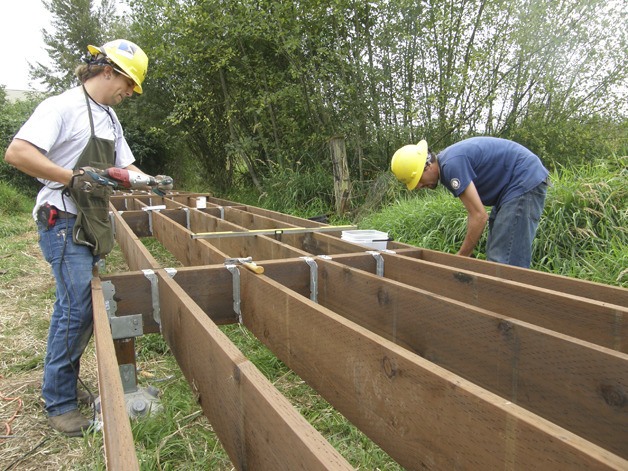Jered Pomeroy, Joe McDonald and Garrett Carr, three young guys from the Olympia area – bright, ambitious, strong and inspired to do something to help the environment.
The Washington Conservation Corps found a use for all that energy, handed the guys wood, saws, transits and measuring tape and sent them Auburnward to build a boardwalk through the fledgling Auburn Environmental Park.
When they wrap up their work in December, Pomeroy, McDonald and Carr will leave behind something solid, something to be proud of – a quarter-mile-long, elevated boardwalk people can stand on to watch the birds and beasts below without disturbing them or their surroundings.
Plans call for the boardwalk to run along most of the 1,200-foot-long pedestrian trail connecting West Main Street with the bird and wildlife viewing tower on Western Avenue. It will be a six-foot wide, wooden structure atop pin pile foundations, with curbing on both sides, and guard rails in places where it rises more than 30 inches above the ground, or where there are areas of seasonal standing water.
The City broke ground on the boardwalk July 26 at the north end of Western Avenue, and the WCC got busy Aug. 1.
The cost of construction cannot top $45,000. Project funding comes in part from a Washington Wildlife and Recreation Program Urban Wildlife grant through the Washington State Recreation and Conservation Office.
“The WCC takes people like us with little-to-no experience,” said the 24-year-old Pomeroy, “and has us come out here and work in a group environment, and work not only for ourselves but for the state of Washington. You sign a contract, and at the end of the year you get a $5,500 scholarship toward any kind of schooling you want to pursue, whether it’s something that WCC has exposed you to or something else. I’m going to use it to pay off my student loans and be debt free.”
The City is developing the 120-acre, first phase of the park to provide an open space that offers opportunities for wetland ecosystem restoration, fish and wildlife enhancement, water quality improvement, ecosystem-oriented and sustainable economic development, storm water detention and flood control, public education and recreation.
Planting party
Volunteers this fall also will plant 2,500 native trees and shrubs in seven planting zones covering 93,000 square feet, along parts of the park bordering the east side of State Route 167 and the north side of West Main Street.
The state legislature set up the WCC in 1983 to conserve, rehabilitate and enhance the state’s natural and environmental resources, while providing educational opportunities and meaningful work experiences for young adults between 18 and 25 years of age. It has worked with local, state and federal agencies to finish numerous restoration, recreation, and stewardship projects across the state, among them elevated wooden bridges and boardwalks. The WCC, with 180 members working throughout the state all year, is funded by sponsor organizations, state money and an AmeriCorps grant from the Corporation for National and Community Service.
“It’s definitely changed a lot in my life,” McDonald, 25, said of the WCC. “Before this, I had never picked up a chainsaw in my life. A couple weeks in and I’m up at Mount Rainier, cutting three-foot-diameter logs and getting them off the trails. You work all over the place and do a lot of things. It’s tough work, but it’s all to benefit the environment. Before this, I did office jobs my whole life.”
Carr, 23, the baby of the group and a Lacey native, has only been with the WCC for two months, but he likes the life.
“I applied a year and half ago and went to an interview but I didn’t get job. My mom told me to try again. I did. I got another interview, and at the last minute they put me on this crew because they were short handed. I’m going to go for another year after this one is up.”
“I’ve always wanted to work in the environment, work in the woods,” Pomeroy said. “It’s just one of those things where you have to fall into the right spot. This job definitely has given me the opportunity to explore an outdoor education. What could be better than that?”


